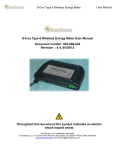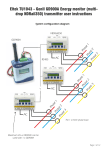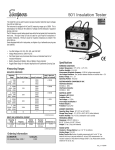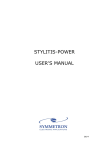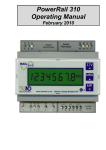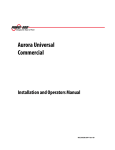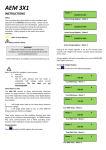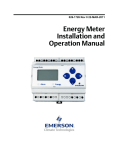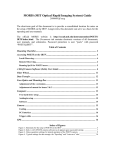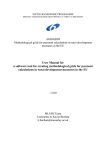Download Operation
Transcript
PowerRail350V Operating Manual Current Sensor Inputs August 2010 Safety 1 Safety This instruction sheet gives details of safe installation and operation of the PowerRail350V electricity meter. Safety may be impaired if the instructions are not followed. Labels on each meter give details of equipment ratings for safe operation. Take time to examine all labels before commencing installation. Safety symbols on the meter have specific meanings. Refer To User Manual Risk of Electric Shock WARNING The meter contains no user serviceable parts. Installation and commissioning should only be carried out by qualified personnel WARNING Risk of Electric Shock Isolate all inputs and supplies to the meter before connecting the current sensors on the load cables or wiring the sensors to the meter. Further information is available at http://www.ndmeter.co.uk. Page 2 Rail350V Operating Manual Operation 2 Operation 2.1 Energy Displays Press to select kWh kvarh and Hours Run display pages. kWh Active Energy Register rh Hours Run kVArh Reactive Energy Register(Note 1) The Hours Run register accumulates the total time during which the average 3-phase load current exceeds a preset level. This is always displayed with a resolution of 0.1hour. The percentage level of (I1+I2+I3) at which the Hours Run register accumulates is user programmable from 1% to 100% of full scale current. Press and together and hold for 2 seconds to reset the hours run register. Scaling of the energy registers is set by the nominal input currents and voltages and remains constant during operation of the meter. Energy registers will each accumulate from zero to 99,999,999 then restart from zero. 2.2 Press Voltage Displays to select from the following displays; V Phase-n Voltages 1 - 3(Note 1) V Line-Line Voltages 1 – 3(Note 1) 2.3 Press Current Displays to select from the following displays; A Phase 1 – 3 Current Rail350V Operating Manual Page 3 Operation 2.4 Power Displays Press to select from the following displays; kW System Active Power Frequency. Hz (Phase 1 voltage) System Power Factor (C=Capacitive) (Note 1) kW Phase 1-3 Active Power(Note 1) Phase 1-3 Power Factor (C=Capacitive) (Note 1) NOTE 1: Some display pages are removed in Balanced Voltage Mode (Refer to section 3.7). 2.5 Pulse Outputs Two isolated pulse outputs are provided for connection to external systems such as Building Energy Management Systems (BEMS), data loggers, remote counters etc. Pulse 1 is associated with the active energy (kWh) register and Pulse 2 with the reactive energy (kvarh) register. A single pulse occurs for each unit of energy on the display (eg 1 pulse per 0.1kWh). The pulse rate (amount of energy associated with each pulse) and pulse length may be set to suit the external system. 2.5.1 Pulse LEDs Light emitting diodes (LEDs) on the front panel of the instrument remain ON during each associated output pulse. Pulse Output Indicators Page 4 Rail350V Operating Manual Programming 3 Programming 3.1 Programming Menu To enter programming mode: Hold and together for 5 Seconds. A Security Code may be required before changes to programmed parameters are allowed. This is only required if a Security Code greater than zero is set via serial communications. This is then stored in non-volatile memory during power interruptions. 4-Digit Security Code To Enter A Security Code: Press or Press to select next most significant digit. to change each digit. (Lowest significant digit first). When a valid code is input the programming menu is displayed. To change a Programmable Value: Press or until the required value is set. To Move to The Next Setting: Press until the next page in the list is displayed. Parameters are set in the following order: Program Menu Pages A Current Sensor Primary V Nominal Line-Line V (or PT Primary) kWh Output Pulse Rate Pulse On Time Pulse Output Test Rail350V Operating Manual Page 5 Programming Hours Run Trip Point (Percent Amps) Voltage Input Mode CT Auto Rotation Mode Changes Are Stored to Non-Volatile Memory After the last parameter is set the new values are stored and the meter continues to measure with the new settings. 3.2 Current Sensor Type Selection (CT) Current sensor types are selected from a table of preferred types identified by their nominal primary current rating. The following types may be selected. 5, 50, 100, 150, 400, 800. Note: Current sensors MUST be from the PowerRail350V range of input devices supplied by the manufacturer. Use of other sensors may affect accuracy & safety 3.3 Nominal Line-Line Voltage Selection (Un) The nominal line-line voltage of the measured supply system may be programmed. For systems without potential transformers (PTs) this should be the same as the nominal input of the meter as specified on the rating label (e.g. 400V). For systems with PTs fitted this should match the nominal primary rating of the PT. The preferred values are: 11, 40, 48, 100, 110, 208, 400, 480, 600, 800, 1000, 1100, 2200, 3300, 4000, 4400, 5000, 7500, 10000, 11000, 15000, 22000, 25000, 33000, 40000, 44000, 55000 3.3.1 Fine Adjust Fine Adjust Mode allows values other than those provided by the default tables to be set. To enter/exit Fine Adjust Mode: and together for 2 Seconds while setting Un. Fine Adjust Mode is indicated by a Hold decimal point after “Un”. 3.4 Pulse Rate Selection Table (Counts) 1, 2, 5, 10, 100, 1000 3.5 Pulse On-Time Selection Table 100ms ,200ms, 500ms, 1s, 2s, 3s, 5s, 10s, 20s Page 6 Rail350V Operating Manual Programming 3.6 Pulse Output Test This feature allows the pulse output hardware and external system connections to be commissioned without a measured load. The LCD shows Pto (off) and Ptr (run) and the number of test pulses. The test pulse rate is set automatically dependant on the programmed pulse length (maximum 0.5Hz). Press to start/stop the test pulses on both outputs. Press and 3.7 together to stop the test pulses and simultaneously reset the test counter. Voltage Input Mode Selection In “Balance Voltage Mode” the PowerRail350 may be connected to a single voltage source in place of the three phases normally required for full accuracy measurement. When Balanced Voltage Mode is enabled the voltage measured on phase 1 is copied to phases 2 & 3 and all three power-factors are assumed to be unity (1.00). In this mode, the voltage connected to phase 1 on the meter may be fed from any of the 3-Phase system voltages. This connection is valid for loads with a near unity power-factor (PF=0.95 equates to an error of 5%) and balanced 3-Phase voltages. The combination of Split Core Current Sensors and Balanced Voltage Mode allows for rapid commissioning where access cannot be made to 3-Phase terminations. At a later date when access is possible, for example during planned maintenance, the meter may be connected safely to the 3-Phase voltages and Balanced Voltage Mode de-selected. Press Mode. or to toggle between Balanced Voltage Mode and True 3-Phase Measurement True 3-Phase Measurement Mode Balanced Voltage Mode In Balance Voltage Mode some display menu pages are removed as they have little or no meaning and voltage is displayed as: V Voltage Display in Balanced Voltage Mode Single Phase kW, Power Factor and kvarh displays are removed while Balanced Voltage Mode is enabled. Rail350V Operating Manual Page 7 Programming 3.8 CT Auto Rotation Mode When “CT Auto Rotation Mode” is selected, the orientation of each Current Transformer (CT) on its respective cable becomes irrelevant. It is therefore possible to pass the cable through the centre of the CT in either direction. In this mode current direction is ignored and all power is assumed to be feeding a load (import). When “CT Auto Rotation Mode” is de-selected (“True Rotation Mode”) current direction is monitored and measurement of import and export power is provided. In both modes it is essential to place each CT on the correct phase conductor associated with the relevant phase voltage: Therefore link CT1 with V1, CT2 with V2, CT3 with V3. PowerRail350 meters are normally supplied with “CT Auto Rotation Mode” selected. In order to detect Positive and Negative power values in all four quadrants it is necessary to de-select “CT Auto Rotation Mode”. In the programming Menu Press True Rotation Mode. or to toggle between CT Auto Rotation Mode and CT Auto Rotation Mode True Rotation Mode NOTE: CT Auto Rotation Mode is not available when Balanced Voltage Mode is selected as all Power Factors are assumed to be unity and current phase and direction is ignored. Page 8 Rail350V Operating Manual Programming 4 Display Scaling The units, Wh, kWh or MWh and the position of the decimal point for the energy/power displays are automatically set dependant on the CT and Un settings for the meter. The nominal 3-phase input for the meter is defined as: Wnom = 3 x Un x CT Where: Un is the nominal Line-Line voltage or PT primary (10V - 55kV). CT is the current sensor nominal primary (10A – 25kA) Un and CT are set in programming mode. The display pages are scaled as follows: The display pages are scaled as follows: Amps Resolution CT 5A 50A 100 A 150A 400A 800A 0.01 A 0.01 A 0.1 A 0.1 A 0.1 A 1A Volts Resolution Un <= 90 V <= 1200 V <= 9,000 V > 9,000 V Wnom < 243 W < 2.43 kW < 24.3 kW < 243 kW < 2.43 MW < 24.3 MW < 243 MW > 243 MW 0.01 V 0.1 V 0.001 kV 0.01 kV kW/kvar kWh/kvarh Resolution 0.1W (var) 0.1W (var) 0.001 kW (kvar) 0.01 kW (kvar) 0.1 kW (kvar) 1 kW (kvar) 0.01 MW (Mvar) 0.1 MW (Mvar) Resolution 0.001 kWh (kvarh) 0.001 kWh (kvarh) 0.01 kWh (kvarh) 0.1 kWh (kvarh) 1 kWh (kvarh) 0.01 MWh (Mvarh) 0.1 MWh (Mvarh) 1 MWh (Mvarh) Rail350V Operating Manual Page 9 Display Scaling 5 Installation 5.1 Mounting On A Rail The PowerRail350V conforms to DIN 43880, 6-Module Wide. The unit is therefore compatible with a number of standard distribution systems with 45mm cut-outs. The meter should be mounted on a 35mm symmetrical (“Top-Hat”) DIN rail of minimum length 106mm. 5.2 Pulse Output Connection The pulse outputs take the form of isolated volt free normally open contact pairs. The contacts are isolated from all other circuits (2.5kV / 1 minute) and at 50V from pulse1 to pulse 2. The pulses can be used as an input to a remote counter, pulse logger, building energy management system etc. Pulse Output Connections Page 10 Rail350V Operating Manual Installation 5.3 Using Current Sensors WARNING Risk of Electric Shock Isolate all inputs and supplies to the meter before connecting the current sensors on the load cables or wiring the sensors to the meter. 5.3.1 Current Sensor Polarity If measurement of positive and negative power is required (True CT Rotation Mode) the current sensors MUST be placed on the load cable with the correct polarity. Refer to Section 3.8 for more information about setting the CT Rotation Mode. The following diagram shows how each device is fitted on the cable for correct operation: NOTE: If a current sensor is placed on the cable in the opposite orientation the associated phase kW reading will be negative. The secondary cables also require wiring with correct polarity. The white cable (or black/white) is the negative and should be connected to S2 or CT- on the meter. The black cable is the positive and should be connected to S1 or CT+ on the meter. NOTES: The output from these current sensors is a low voltage. It is safe to leave these outputs open-circuit if not connected to a meter. The output connections from these current sensors must be individually wired direct to the meter and must not be earthed or connected to any other circuit. If the sensor secondary cables require extending care must be taken to avoid pickup of electrical interference. With suitable low capacitance screened cables, the cable can be extended to 100m or more. Examples of suitable cables include Belden 9841, Alpha 6412 and equivalents; also multipair versions of these cables. This cable must have an insulation rating >250V. Current sensor polarity is irrelevant in Auto CT Rotation Mode. (refer to Section 3.8) Rail350V Operating Manual Page 11 Standard Connections 6 Standard Connections 3-Phase 3 or 4-Wire (*Optional Neutral) Single Phase Page 12 Rail350V Operating Manual Installation Balance Voltage Mode NOTE: In Balanced Voltage Mode L1, L2 or L3 may be used as the voltage input to V1 as phase is assumed to be zero in all measurements. Balanced Voltage Mode must be selected in the programming Menu (Refer to Section 3.7) in order to obtain meaningful measurements. WARNING Ensure the supply connected to L-N (Aux Supply) and Vn-V1 (Voltage Input) is rated in accordance with the individual meter rating labels. Rail350V Operating Manual Page 13 Specification 7 Specification INPUTS System Voltage Un Current Sensors Output @ Nominal In Accuracy ND SCL8-5 ND SCL16-50 ND SCL16-100 ND SCT19-150 ND SCT32-400 ND SCT51-800 Enclosures Insulation Environment Measurement Range Frequency Range Voltage Burden Overload 3 Phase 3 or 4 Wire Unbalanced Load 400/230V. 3 Phase 3 or 4 Wire 110/63V, 120/240V & 208/120V optional. Others to order. 0.333Vac ±1% (0.1In – 1.2In) In = 5A; Max Cable = 8mm Dia. Phase Error <2.5 at 0.5In In = 50A; Max Cable = 16mm Dia. Phase Error <2.5 at 0.5In In = 100A Max Cable = 16mm Dia. Phase Error <2 at 0.5In In = 150A Max Cable = 19mm Dia. Phase Error <2 at 0.5In In = 400A; Max Cable = 32mm Dia. Phase Error <2 at 0.5In In = 800A; Max Cable = 51mm Dia. Phase Error <2 at 0.5In UL94V-0 >300Vrms, CAT III Indoor use only (Altitude < 2000m) Voltage 50% to 120% Current 0.2% to 120% Fundamental 45 to 65Hz Harmonics Up to 30th harmonic at 50Hz Individual to the 15th <0.1VA per phase Voltage x4 for 1 hour Current SCL x10 for 1min SCT19 200A Continuous SCT32 800A Continuous SCT51 2000A Continuous DISPLAY Type Data Retention Format Scaling Custom, Supertwist, LCD with LED backlight 10 years min. Stores kWh & Meter set-up 8 x 6.66mm high digits with DPs & 3.2mm legends Direct reading. User programmable CT & VT CT Primary programmable from 5A to 25kA VT primary programmable from 11V to 55kV Wh, kWh, MWh etc. depending on user settings Legends AUXILIARY SUPPLY 230V 50/60 Hz ±15% Standard 110V 50/60 Hz ±15% Options 2VA max. Load x1.2 continuous Overload METER ACCURACY All errors ± 1 digit Better than Class 1 per EN 62053-21 & BS 8431 kWh Better than Class 2 per EN 62053-23 & BS 8431 Kvarh Better than Class 0.25 IEC 60688 kW & kVA Better than Class 0.5 IEC 60688 kvar Class 0.1 IEC 60688 (0.01In – 1.2In or 0.1Un – 1.2Un) Amps & Volts ±0.2° (0.05In – 1.2In and 0.2Un – 1.2Un) PF Class 0.5 IEC 60688 (0.05In – 1.2In) Neutral Current Page 14 Rail350 Operating Manual Specification OVERALL METERING ACCURACY Better than Class 2 Meter with Class 1 CTs ND SCL8-5 5 Amp Better than Class 1 Meter with Class 1 CTs ND SCL16-50 50 Amp Better than Class 1 Meter with Class 1 CTs ND SCL16-100 100 Amp Better than Class 1 Meter with Class 1 CTs ND SCT19-150 150 Amp Better than Class 1 Meter with Class 1 CTs ND SCT32-400 400 Amp Better than Class 1 Meter with Class 1 CTs ND SCT51-800 800 Amp PULSE OUTPUTS 1 Pulse per unit of energy Function Settable between 1 & 1000 counts of kWh register Scaling 0.1 sec. default; Settable between 0.1 and 20 sec Pulse Period < 2.0ms Rise & Fall Time N/O Volt free contact. Optically isolated BiFET Type 100mA ac/dc max., 100V ac/dc max. Contacts 2.5kV 50Hz 1 minute Isolation MODBUS® Serial Comms RS485 2 wire + 0v. ½ Duplex, ¼ unit load Bus Type MODBUS® RTU with 16 bit CRC Protocol 4800, 9600 or 19,200 User settable Baud Rate 1 – 247 User settable Address Reply within 250ms max. Latency New command within 5ms of previous one Command Rate GENERAL Operating -10°C to +65°C Temperature Storage -25°C to +70°C < 75% non-condensing Humidity IP54 standard, IP65 optional Environment MECHANICAL Rising Cage. 4mm2 (12 AWG) cable max. Terminals DIN 43880, 6-Modules Wide Enclosure Noryl® with fire protection to UL94-V-O. Self extinguishing Material 106 x 90 x 58mm (Cut out 106 x 45mm) Dimensions ~ 250 gms Weight SAFETY EN 61010-1 Installation Category III & BS 8431 Conforms to E. & O. E. © Northern Design (Electronics) Ltd, March 2008 Rail350V Operating Manual Page 15















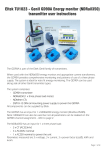
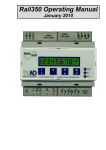
![Manual 08 [colour match]](http://vs1.manualzilla.com/store/data/006024659_1-3bda8edcd573634c82e14bf074c48937-150x150.png)
